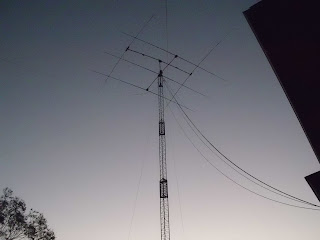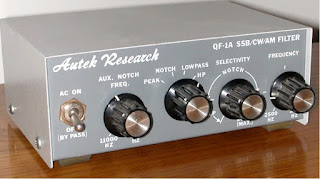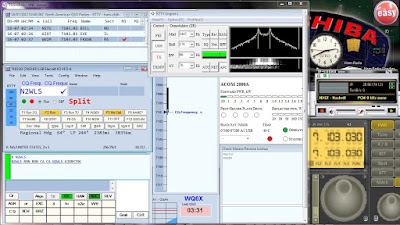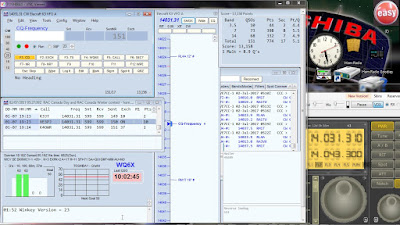[This BLOG entry is dedicated to my late brother-in-law Ken Triplett who recently
left this plane of existence for yet another journey. Wherever you may be my friend, you will always be remembered.
After your memorial event, during the IOTA contest I searched the radio bands looking for new islands to communicate with.
Several different times during the wee hours I felt your always curious-presence as you marveled at the thousands of amateur radio stations who struggle to communicate wirelessly across the ether while your presence more-easily makes itself
known, with no struggle at all
May your journey of the spirit
be a JOYOUS ONE.]
 |
| NX6T undergoing a computer & power strip revamp |
On the Air) radiosport contest was way back in 2012, running a portable setup from Alameda hoping
it would qualify as an island; it didn't. Wanting to up my 2017 contest entry count, seeing the 2017
IOTA GiG on the WA7BNM contest calendar prompted me to give it another try; this time only
as an island CHASER. [CLICK HERE] to see the RSGB IOTA contest rules.
Because IOTA is an RSGB contest the starting time is 12:00z (5am PDT) for a total 24 hours.
While I was able to make the 12:00z start on Saturday and operate to the 12:00z end on Sunday, funeral attendance and family obligations kept me off the air from 15:00z to 05:55z. However once
I fired up for the evening on 40 meters, I kicked the momentum into higher gear.
Because STN-1 @ NX6T has been recently revamped, N6KI encouraged me to put the entire setup through a remote access "stress test".
Minus a little bit of internet "burbling" Saturday morning, overall the new station changes worked very well.
Space WX wise while we were not up against a K-index of 5 or an A-Index of 50, having a K-Index
of 2 was just bad enough to be an annoyance.
On 40-meters, the noise level was consistently S-6 with fast-fade QSB, requiring many repeats. Typically, when I ask for a repeat of specific piece of information (UR NR AGN?), stations send the WHOLE exchange; which is NoT what I want. Because of quick-fading, when you send the WHOLE exchange, after I beautifully hear "599", the serial-# quickly fades into the noise. The solution is to do what I do - define a SINGLE function key SPECIFICALLY for EACH piece of information. Then when asked, press the function for JUST that information.
To make things easier I ran the Elecraft K3 barefoot. Running it into the ACOM 2000a amplifier would have entailed engaging the shack's newly installed A/C system; another variable that
would have required my side-attention.
When I run remote, I have enough different things to be aware of. If this were a multi-OP operation, having other operators there would allow the A/C to be properly configured at all times, making an HP entry the way to go.
For this operation, it was not a matter of whether or not other stations could hear my signal; if I could hear them, I could eventually work them. All operations were conducted from antennas supported by Tower #2; a 3-el Stepp-IR for the high bands, 2-elements on 40 and a droopy Inverted Vee on 80, yielding 2 Texas stations and P40X in Aruba.
The RSGB IOTA contest is unique in that we don't transmit locational zones (as in the CQ WW
and IARU contests), nor do we transmit state locations or power levels (as in the ARRL DX contest). Instead, the sought after stations (islands) transmit 599, a serial # and an island designator, while
the rest of us simply transmit 599 and a serial #. The island designator consists of a continental abbreviation (NA, SA, EU, AF, AS & OC) followed by a number specifying the specific island.
This year there were no AF stations and only one SA entry in the WQ6X Log.
Because I started late on Saturday evening, 20 was open only to OC; for Europe, 40 meters
yielded only CR2 & CR5. Because contacts with island stations are worth 15 points (non-island stations only 2 points), operating from the "Pacific Rim" certainly has it's advantages. By definition, Japan is considered an island (AS-007) as is Hokkaido-JA8 (AS-077). While JA stations were plentiful I was hoping for more; especially on 80 meters. Unfortunately, many Japanese stations did not know to send the AS-007 designator, which was initially confusing. If I hadn't entered those as AS-007 anyway, N1MM would have scored the QSO as a 2-pointer, not 15.
To make remote operation easier,
I PURPOSELY chose to run as an Assisted station. Surprisingly, all the spots I clicked on were valid; both in callsign AND frequency.
In some contests, unscrupulous operators purposefully MIS-SPOT stations; which has happened to me. Because I chose to run frequencies during much of the OP time, the CW skimmers quickly picked up on my CQ's. One advantage of the skimmers is their accuracy. While someone may accidently
(or purposefully) mis-spot me, because there are so many skimmer radios scouring the bands,
incorrect spots are often corrected within minutes.
As in previous remote operations, inserting an old-school Autek QF-1A filter between the laptop audio and the headphones made a BiG difference.
Running the Elecraft radio remotely via the RCForb software, doesn't not make it easily to switch in the different DSP filters in the K3.
Depending on the different noise characteristics, the NR-DSP yields wide-varying results;
making the QF-1A an absolute MUST for running CW contests remotely.
QRM-wise, CW contest activities on 40 meters almost always attract intentional QRM IDIOTS.
While I don't like it, I have somewhat gotten used to the daily influx of Indonesian SSB stations
around 7.022 (SSB operations in Region 1 are not allowed below 7.050). However I DO NOT
expect SSB activity on 7009.09. Unfortunately, @ 08:13z I was barraged by an Asian voice doing what seemed like some sort of religious chanting. SSB heard thru the tight filtering of the QF-1A sounds unnervingly HORRIBLE. Because the station was EXACTLY on frequency, I knew his frequency-choice was NO ACCIDENT; it was INTENTIONAL. Luckily (unlike other contests)
this SSB QRM did not follow me when I moved up to 7012.12.
Additionally, typical to most CW contests, there is always at least ONE IDIOT who makes a QSO
with me and then IMMEDIATELY moves barely 200-hz away to start calling CQ. This contest, the BONE-HEAD award goes to KZ5D @ 11:53z; just before the contest end. I temporarily shifted up 200-hz and sent "QRL QSY"; which he ignored several times.
When I sent "QSY LID" he disappeared.
While I bitch about the operation of Russian military beacons on 7.039+, like the NCDXF propagation beacons on the upper bands, they DO serve a bit of a purpose - they give me a sense of the propagation characteristics between California and various locations in Asia. For this IOTA
contest, only the "M" beacon (Magadan) was heard; altho not very loud.
A situation unique to IOTA were stations that qualified as islands (such as V73NS) who were evidently NoT in the contest. The IARU rules state that if a station does not send a serial # to
put in 0 for that entry. While I did that, the N1MM+ software would issue a warning message
when I attempted to actually log the contact. Telling the software to log the contact anyway
yielded the 15 points ONLY if the island designator were entered.
Overall I found the 2017 IOTA contest a unique challenge. My only real disappointment is that I was unable to get on 40 meters during the 02:00z - 05:00z, when European signals typically make their way to the San Diego area. Because I would like to be a sought-after island station, look for WQ6X next year with an "NA" island designator in the IOTA contest.
 |
| RSGB IOTA ending screen for WQ6X |
Did YOU work the RSGB IOTA contest?
How many Island stations did YOU work?
Is WQ6X in YOUR Log?
















































